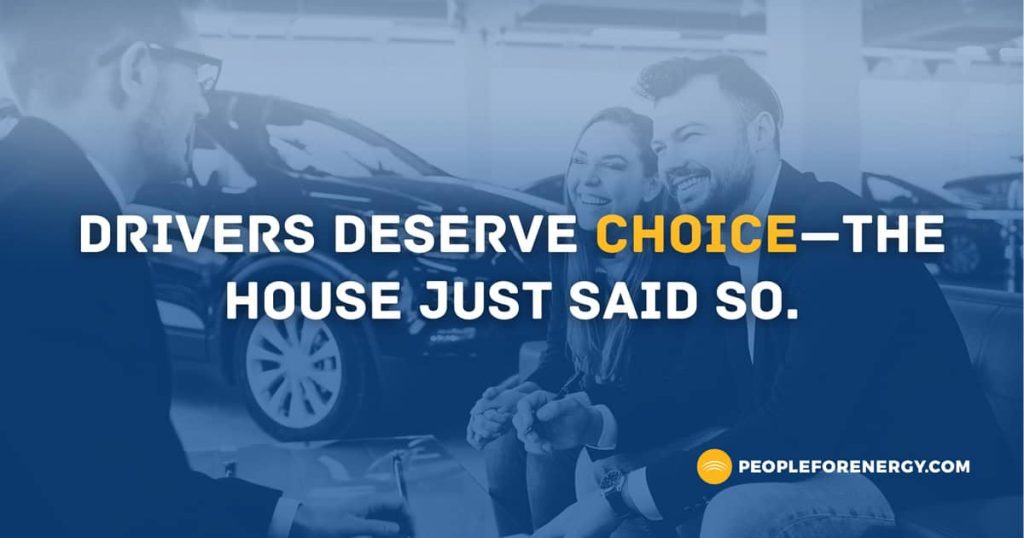California wants to ban the sale of new gas and diesel vehicles starting in 2035. That means if you’re shopping for a new car in the future, your only option in the state could be an electric or hydrogen-powered vehicle—regardless of where you live or what kind of vehicle works best for your needs.
This rule, known as Advanced Clean Cars II, is getting national attention. The U.S. House of Representatives recently voted to block states like California from enforcing this type of ban. The goal? To protect consumer choice and prevent higher costs for drivers and small businesses.
Consumer Energy Alliance supports this action because Americans should have the freedom to choose the vehicle that fits their lives and budgets—not be forced into one-size-fits-all policies.
What Is the 2035 Zero-Emission Mandate?
California’s plan would require that all new cars, trucks, and SUVs sold after 2035 be zero-emission vehicles (ZEVs)—which includes electric and hydrogen-powered models. Traditional gas and diesel vehicles would no longer be available as new options.
While the goal is to reduce emissions and improve air quality, this rule could make everyday life harder and more expensive for families, workers, and small business owners.
Why Are People Concerned?
- Electric Vehicles Are Still Expensive
Electric vehicles today cost around $60,000 on average. That’s about $12,000 more than a typical gas-powered car. Even with tax credits or rebates, that’s still a big gap—especially for families on tight budgets, seniors on fixed incomes, and small business owners who rely on vehicles for work.
- Consumer Choice Is at Risk
This mandate removes gas and diesel options from the new car market. If you need a vehicle with long range, affordable repair costs, or towing capability, you may have fewer options after 2035.
Used gas-powered vehicles will still be sold, but supply could shrink over time and prices may go up due to demand.
- The Power Grid Isn’t Ready
California’s electricity grid already struggles with rolling blackouts and high demand. Adding millions of electric vehicles will put more pressure on a system that’s already strained.
That could lead to higher electricity bills for everyone—not just EV owners—and reduce the reliability of power during heat waves, wildfires, and peak demand.
- Infrstructure Gaps Will Create Access Issues
Today, California has about 94,000 public charging stations. To meet future demand, the state will need more than 1.2 million by 2030. Many communities, especially in rural or lower-income areas, don’t have access to chargers.
This transition also depends on scarce minerals like lithium and cobalt, which are needed to make EV batteries. These materials are limited and come with their own supply chain risks that could drive up costs or delay production.
Congress Is Taking Notice
The U.S. House of Representatives has now voted to stop states like California from banning gas and diesel vehicle sales. The measure would reverse a federal waiver that allows states to set more aggressive vehicle emissions rules than the national standard.
Energy policy should be practical and protect people’s ability to choose what works best for them. Drivers and businesses shouldn’t be penalized because their state adopts rules that reduce options and raise prices.
More and more lawmakers are recognizing that cleaner energy goals should be met with solutions that work for real people—not just mandates that sound good on paper.
What It Means for You
If you live in California:
- All new vehicles sold after 2035 must be electric or hydrogen-powered.
- Used gas and diesel vehicles will still be available, but may be harder to find and more expensive.
- Electricity costs could rise as more drivers charge vehicles and demand grows.
- Charging access may be limited, especially if you live in an apartment or older home without a garage.
Even if you don’t live in California:
- Other states may follow suit, adopting similar rules.
- Congressional action could shape whether this becomes a nationwide trend.
A Better Way Forward
We all want cleaner air and better energy options. But the path we take to get there matters.
A better approach:
- Keeps a range of vehicle options available—including gas, hybrid, electric, and hydrogen models.
- Invests in a stronger, more reliable electric grid before increasing demand.
- Expands charging infrastructure in every community, not just cities.
- Supports dispatchable energy sources like natural gas and nuclear to meet growing electricity needs.
- Policies should help—not hurt—people’s ability to afford transportation, power their homes, and run their businesses.
Final Thought
California’s clean car rule is meant to reduce pollution, but it also risks raising costs, limiting choices, and placing added pressure on a power grid that’s already struggling.
The good news is that Congress is taking steps to push back on policies that may do more harm than good. This is a chance to reset the conversation—so we can move toward cleaner, smarter, and more affordable energy solutions that protect families and communities along the way.
